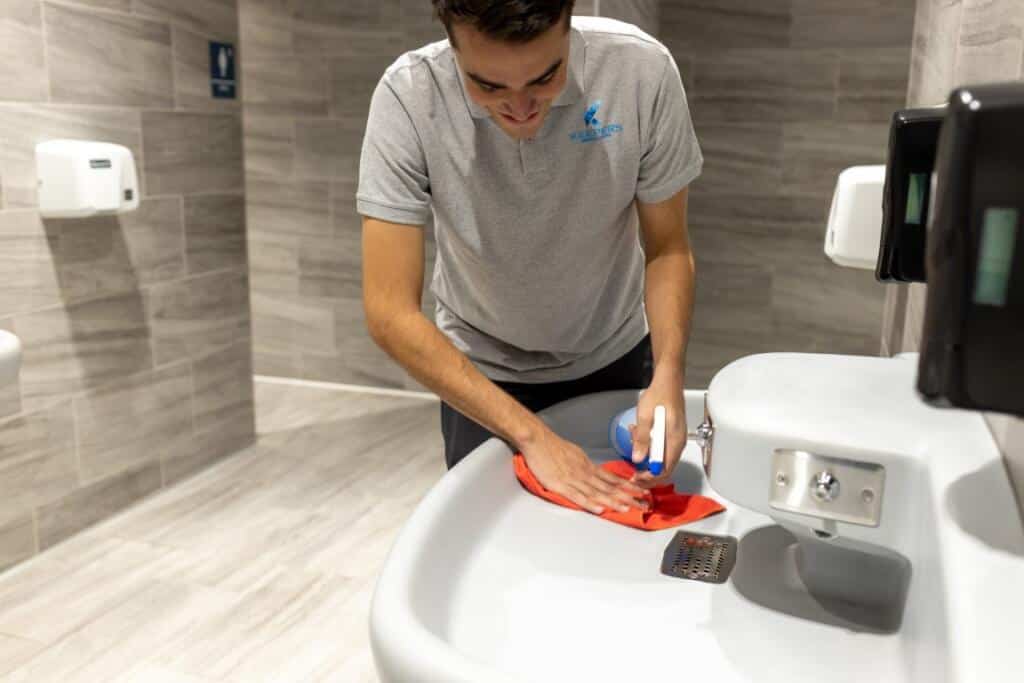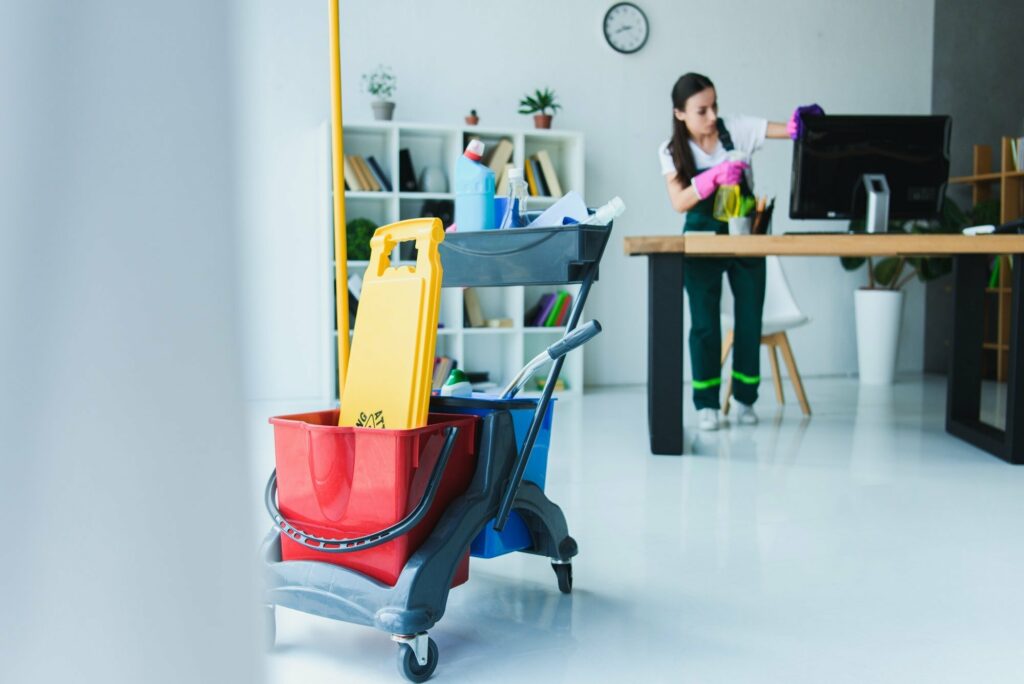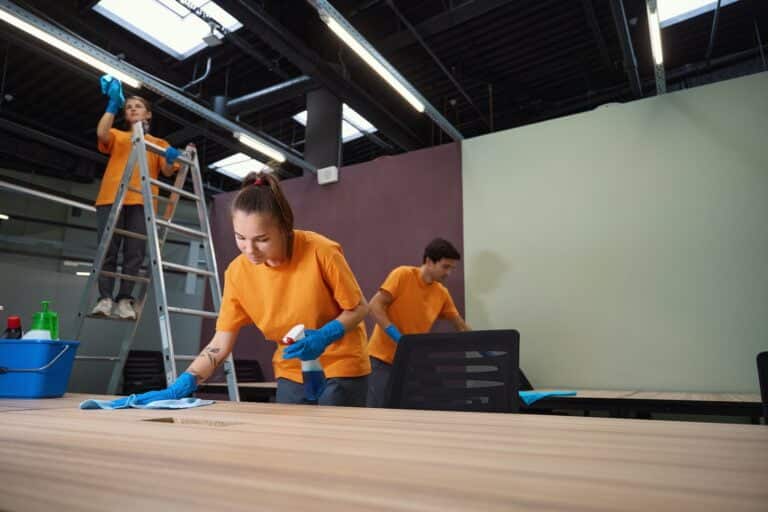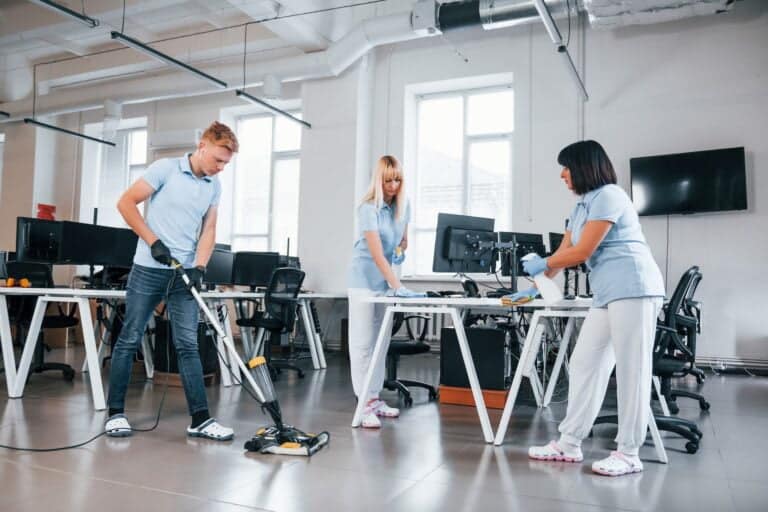Dust and Dust mites
Spring is a season of renewal and rejuvenation, but for many people, it also means the onset of allergy symptoms. Allergies such as asthma, hay fever, and mold allergies can significantly impact workplace productivity and employee health.
One of the most common allergens found in offices is dust and dust mites. Dust mites are microscopic creatures that feed on human skin flakes and thrive in warm, humid environments.
These pests are often found in carpets, upholstery, and other soft furnishings. Dust can cause several respiratory problems for people with allergies or asthma.
Symptoms may include sneezing, runny nose, nasal congestion, itchy eyes or throat, coughing or wheezing. Fortunately, there are ways to limit the amount of dust in the workplace to prevent these symptoms from occurring.
Regular vacuuming with a HEPA filter vacuum cleaner is one effective way to remove dust particles from carpets and upholstery. It’s essential to clean these areas thoroughly since they tend to accumulate an enormous amount of dust over time.
Additionally, removing clutter from surfaces around the office can make cleaning much easier. Another way to reduce exposure to dust mites is by using air filters that trap small particles like pollen or pet dander before they can enter your lungs.
These filters work best when installed in your HVAC system so that air circulates through the entire building. Overall it’s essential to take steps towards reducing exposure to allergens such as dust at work since this directly affects our lung health and overall productivity at work.
Symptoms include:
Symptoms of allergies caused by dust and dust mites can vary from person to person, but some common symptoms include sneezing, a runny or stuffy nose, itchy or watery eyes, and itching in the nose or throat. For people with asthma, exposure to dust and dust mites can also trigger wheezing, coughing, and shortness of breath. These symptoms can be particularly disruptive in the workplace and can negatively impact productivity.
To limit the impact of dust and dust mites on respiratory health at the workplace, it’s important to identify potential sources of these allergens. Carpets, upholstery, and stuffed animals are all common harbors for dust and dust mites.
These materials can trap allergens deep within their fibers where they cannot easily be removed through normal cleaning. In order to minimize exposure to these allergens at work, regular vacuuming with a HEPA-filtered vacuum cleaner is recommended.
Additionally, carpets should be deep cleaned every 6-12 months by a professional cleaning service that uses hot water extraction or steam cleaning methods. Upholstery should also be regularly cleaned using a vacuum cleaner or steam cleaner as well as washed if possible.
Limiting dust and dust mites:
Limiting dust and dust mites is an essential step in preventing allergies at the workplace. Dust and dust mites are some of the leading causes of allergy symptoms, which can include sneezing, coughing, itchy eyes, and a runny nose.
Dust consists of a variety of particles such as pollen, dirt, mold spores, and pet dander that can trigger allergies. Dust mites are tiny insects that feed on dead skin cells from humans and pets; they can thrive in humid environments.
One way to limit dust and dust mites is by vacuuming carpets regularly. It’s essential to use a vacuum cleaner with a HEPA filter to trap allergens efficiently.
Upholstery should also be cleaned regularly as it can harbor pet hair and dust. Air filters should be changed or cleaned every three months to ensure they’re working correctly.
HVAC systems play an integral role in maintaining indoor air quality; proper ventilation is necessary to reduce the concentration of allergens. Another crucial element in limiting dust and dust mites is addressing sources of moisture in the workplace because these pests thrive in humid environments.
A dehumidifier can help maintain optimal humidity levels between 30-50% within office spaces by removing excess moisture from the air. Reducing clutter also helps eliminate areas where dusty items might accumulate over time.
Limiting dust and dust mites requires regular cleaning practices such as vacuuming carpets, cleaning upholstery with HEPA vacuums or steam cleaners , changing air filters on HVAC systems every few months, reducing humidity levels with dehumidifiers when necessary while addressing moist areas within offices spaces such as bathrooms or kitchens reduces the likelihood of developing allergies at work. By keeping workplaces clean and free from allergens altogether , employees could be more productive as they concentrate better when not worried about their allergies acting up all day long .
Mold Allergies
are a common problem in workplaces, especially in humid and poorly ventilated areas. Mold spores can cause severe allergic reactions, asthma attacks, and respiratory problems. If you notice any signs of mold growth or musty odors in your workplace, it’s essential to take immediate action to prevent health hazards.
One of the most effective ways to reduce mold growth is to control moisture levels. Mold thrives in damp environments, so it’s crucial to keep your workplace adequately ventilated and dry.
Use dehumidifiers and air conditioners to maintain humidity levels between 30% and 50%, as recommended by the Environmental Protection Agency (EPA). Another way to reduce mold growth is to fix any water damage or leaks promptly.
Water damage can provide an ideal breeding ground for mold spores, so it’s crucial to address any issues immediately. Make sure that all plumbing fixtures are functioning correctly, and check for leaks around windows, doors, and roofs.
Regular cleaning is also essential for preventing mold growth in the workplace. Use appropriate cleaning solutions that can kill molds like vinegar or bleach when cleaning surfaces prone to molding like sinks bathrooms etc., vacuum carpets regularly with a HEPA filter-equipped vacuum cleaner as this type of vacuum cleaner traps tiny particles such as mold spores effectively meaning they will not go back into the air during vacuuming.
If possible get an antibacterial UV lamp installed in your workplace; these lamps emit ultraviolet light that kills harmful germs including molds. Preventing mold allergies at work involves proper ventilation and controlling moisture levels in the workplace while ensuring regular cleaning practices are implemented.
Employees should be vigilant for signs of water damage or musty odors which could lead to serious health hazards if left unchecked over time. By taking a proactive approach towards reducing indoor allergens such as molds through deep cleaning measures coupled with regular maintenance practices like changing HVAC filters regularly after every few months will certainly ensure better indoor air quality and a healthy workplace for all employees.
Symptoms include:
Allergies can cause a variety of symptoms, depending on the individual and the allergen.
Common allergy symptoms include sneezing, coughing, runny or stuffy nose, itchy eyes or nose, and skin rash. For those with respiratory allergies such as asthma and hay fever, breathing difficulties and lung health may be affected.
Symptoms from pet allergies may include itchy eyes, hives or rash on the face or chest area, shortness of breath or wheezing. Mold allergies can cause respiratory issues such as sneezing, runny nose and nasal congestion similar to hay fever.
Itchy eyes and skin rashes are also common symptoms of mold allergies. A person with mold allergy may also have difficulty breathing due to a constricted airway which is often more severe in those with asthma.
Dust mite allergies can cause a range of symptoms including sneezing, runny nose and nasal congestion similar to hay fever. In addition to these common symptoms people with dust mite allergies can also experience: watery or itchy eyes; itching; postnasal drip; cough; facial pressure and pain; swollen blue-colored skin under the eyes; decreased sense of smell or taste; trouble sleeping caused by shortness of breath
It is important to note that some individuals may not experience any noticeable allergy symptoms at all despite exposure to allergens in their workplace environment. However these invisible exposures over time could lead to long-term health issues such as chronic inflammation that can often lead to other problems including cardiovascular disease.
Methods to reduce mold and mildew growth:
Mold and mildew are fungal growths that can lead to respiratory issues such as allergies and asthma, especially in those with pre-existing conditions. A damp or humid work environment is a perfect breeding ground for these fungi.
Therefore, it is crucial to take steps to reduce their growth within the workplace. One of the most effective ways to prevent mold and mildew from growing in the workplace is by controlling humidity levels.
A hygrometer can be used to measure the humidity level in a room accurately, and if it exceeds 60%, it’s time to use a dehumidifier. A dehumidifier will remove excess moisture from the air, reducing mold’s ability to grow.
If there’s water damage in the office due to leaks or flooding, those areas should be cleaned up immediately as water can lead to mold growth within 24-48 hours. Ventilation is another critical factor in controlling mold and mildew growth.
Proper ventilation ensures that fresh air enters into space while stale air is exhausted out of it. An HVAC system with clean filters can provide adequate ventilation; however, sometimes additional measures like opening windows or using exhaust fans may be needed.
HVAC filters are designed to trap dust particles and other indoor pollutants but do an excellent job of filtering out small particles like mold spores too. Regularly changing HVAC filters will help reduce the airborne concentration of these spores.
Controlling humidity levels, improving ventilation systems, cleaning up water damage immediately, regularly changing HVAC filters all contribute significantly towards preventing mold and mildew growth at workplaces. It’s always better safe than sorry when it comes down taking care of employee lung health by keeping indoor air quality under control during spring cleaning or throughout the year.
Pet Allergies
Allergies to pet dander are common among people who work in workplaces that allow employees to bring their pets. Symptoms of pet allergies include sneezing, a runny nose, itchy and watery eyes, and hives.
Pet hair is not the only thing that causes pet allergies; dander, urine, and saliva also contribute to the problem. If you are sensitive to pet allergens, you should take steps to avoid exposure.
One way to prevent dander allergies is through upholstery cleaning. Using a vacuum with a HEPA filter can help remove allergens from carpets and upholstery.
Additionally, frequent vacuuming of carpets and upholstery can help reduce the number of allergens in your office. Regular cleaning of air filters can also be beneficial as it helps trap airborne pet allergens before they circulate around the office.
Another important step in avoiding exposure to pet allergens is implementing a strict “no pets” policy in the workplace if possible. If such policy does not exist in your company, consider getting an air purifier for allergy sufferers.
Air purifiers have an advanced filtration system that captures airborne particles like dander that can trigger allergic reactions. If you bring your own pets into work spaces shared with coworkers who might be sensitive or allergic to pet dander or hair, try keeping them close by during working hours so as not to expose other coworkers inadvertently.
You should also ensure your pets are regularly groomed as well as clean their environment frequently. By taking these simple precautions at workspaces allowing pets like dogs or cats present; you can protect yourself from allergies while still enjoying the benefits of having furry friends around at workspaces they’re welcome in!
Symptoms include:
When it comes to allergies, the symptoms can vary depending on the type of allergy a person has.
Dust and dust mite allergies often present with symptoms like sneezing, coughing, and itchy eyes. Those with mold allergies may experience nasal congestion, watery eyes, and difficulty breathing.
Pet dander allergies can cause similar symptoms as dust and mold allergies, but may also include skin rashes or hives. It’s important to note that symptoms can range in severity depending on the individual’s sensitivity to the allergen.
For some people, exposure to a small amount of pet dander can cause severe reactions while others may only experience mild discomfort. Allergy symptoms can also be mistaken for common cold or flu symptoms which is why it’s important to know what allergens you are sensitive to.
If you suspect that you have an allergy, it’s important to speak with your doctor for proper diagnosis and treatment options. There are over-the-counter medications available for symptom relief as well as prescription options for more severe cases.
Limiting exposure to known allergens is also key in managing allergy symptoms. This is where workplace cleaning protocols come into play as regular cleaning practices reduce the amount of allergens in the air which helps prevent allergic reactions from occurring in employees who are sensitive.
Things you can do to prevent dander allergies at the office:
To prevent dander allergies at the office, there are several things you can do. First, it’s important to establish a pet policy in the workplace.
Having clear guidelines for pets in the office will help ensure that pet dander is kept under control. If possible, it’s also best to keep pets out of the office altogether to prevent any potential issues.
Another way to prevent dander allergies is to use UV light air purifiers. These air purifiers use UV-C light technology to kill bacteria, viruses, and other allergens that can cause respiratory problems such as asthma or allergy symptoms like runny nose and itchy eyes.
The UV light works by breaking down the DNA of these microorganisms so they cannot reproduce or spread throughout your workspace. You should always prioritize regular cleaning.
Upholstery and carpeting can hold onto pet hair and dander for a long time without proper cleaning. Consider using HEPA filters on vacuum cleaners and air purifiers in order to capture harmful particulates from pet hair and fur in the environment.
Preventing dander allergies at work requires establishing clear guidelines regarding pets in the office, considering using UV light air purifiers for effective allergen control, and prioritizing regular cleaning and maintenance routines aimed at keeping your indoor environment free of harmful particulates responsible for triggering allergy symptoms and respiratory issues among employees. By taking these simple steps into consideration during spring cleaning activities or as part of regular commercial cleaning services provided by professional janitorial teams at your workplace facility management program, we can ensure a healthier work environment for everyone involved while promoting productivity through improved indoor air quality standards all year round!
Conclusion
Spring cleaning can be a crucial step in preventing allergy symptoms from flaring up in the workplace.
By following best practices for dust and dust mite control, mold prevention, and reducing pet allergens, employees can enjoy better indoor air quality and improved respiratory health. Monitoring humidity levels with a hygrometer and using a dehumidifier as necessary can help prevent the growth of mold and mildew.
Adequate ventilation and regular HVAC filter changes can also help reduce allergens in the indoor air. Deep cleaning of carpets, upholstery, and other surfaces on a regular basis is essential to combatting dust accumulation.
Janitorial solutions should be used to clean these surfaces as well as other frequently touched areas such as door handles. Regular vacuuming with vacuums equipped with HEPA filters is also important for removing dust mites and pet dander.
It’s important for employers to recognize that investing in commercial cleaning services is an investment in their employees’ productivity and overall health. Implementing a pet policy that limits or eliminates pets in the workplace may also be necessary to reduce allergy symptoms for affected employees.
By taking these steps, employers can create an environment where their employees feel comfortable and healthy year-round. So let’s embrace spring cleaning not only because it makes our office look neat but also because it provides us with fresh air that can improve our daily work lives!














